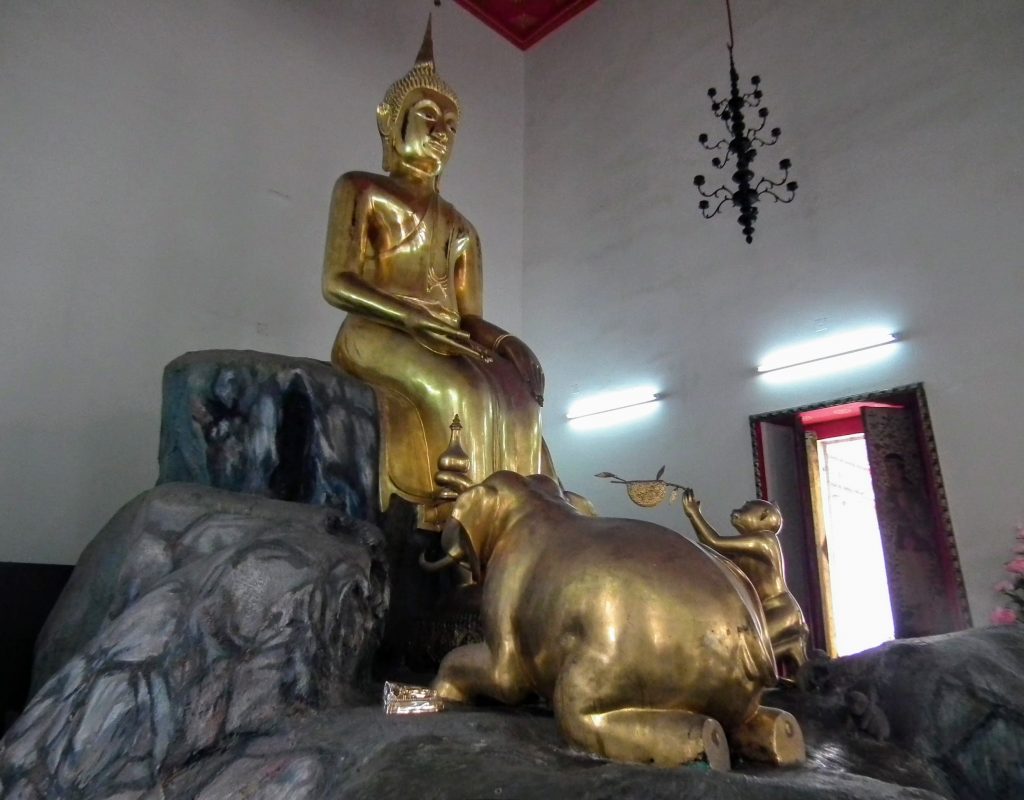
The story is a charming analogy of how the mind works; the Buddha is the enlightened mind; the elephant represents qualities of mind we need to develop, and the monkey represents the mind of the average person that is easily distracted.
The Buddhist legend of the Buddha, the elephant and the monkey should not be confused with a piece of Buddhist artwork that also involves an elephant and a monkey. Albeit, the two portrayals do allude to the same meaning.
In the artwork, a Buddha is seen chasing a black elephant that is being terrorised by a monkey. The scene at the bottom of the hill represents the distracted mind. When the Buddha catches up with the elephant and takes control, the elephant transforms into a beautiful white creature and the monkey gives up the chase. The elephant and the Buddha continue to the top of the hill undisturbed.
This iconography is one way of using animals to describe the nature of the human mind. But both the elephant and the monkey have other qualities that are also used to teach initiates how to develop attributes that improve your quality of life.
Do you know the Buddhist myth of the elephant and the monkey serving the Buddha in Rakkhitawan forest? If not, you will like this story and can probably associate with it on several levels:
During his ninth year of ministry, Buddha Gautama resided at a temple in Kosambi. The temple was the home of Buddhist monks that supported two schools of thought on Buddhism. Subsequently, they were always arguing about which philosophy was right. Siddhartha attempted to settle the quarrels, but the stubborn monks continued to argue amongst themselves.
Tired off their bickering, the Buddha decided to retreat from the temple and set up camp in the nearby hills of Rakkhitawan Forest. (Rakkhitawan Forest is specifically related to the Thai version. In other versions, the Buddha retreats to Parileyyaka Forest). When news of his arrival spreads amongst the animals, an obedient elephant comes to serve him.

Each day the elephant would bring the Buddha fruits and perform tasks for him to make his stay more comfortable. Lord Buddha was very grateful for the elephant’s attentiveness and dedication.
The Buddha accepted the gift graciously and laid it to one side. Later, noticing the honeycomb had gone untouched, the monkey examined the gift to determine why the Buddha had not indulged in the nectar. Upon examination, the monkey noticed some unhatched eggs and immediately understood why the Buddha had not touched the honeycomb.
To rectify the matter, the monkey removed the eggs and returned them to the hive. Siddhartha, in acknowledgement of the monkey’s good deed, ate the nectar. The monkey was so overjoyed the revered Buddha had accepted his gift that he began leaping from tree to tree and swinging from the branches.
However, in his excitement, the monkey became complacent and lost his grip. He fell and impaled himself on a spike protruding from the ground. The monkey died. But because his good deeds were recognised by Lord Buddha, he was reincarnated in the World of the Thirty-Three Gods.
The story of the Buddha being served by the monkey in Rakkhitawan Forest/Parileyyaka Forest reflects the state of mind and the qualities you have to develop to improve your quality of thought and action.

In Buddhist symbolism, the elephant represents inner strength and patience, attributes you need to develop in order to achieve purity of mind. The elephant brought fruits to Lord Buddha in recognition that he had already achieved mastery over his mind.
However, even Buddhas sometimes need to be reminded of the greatness. The only reason the Buddha was in the forest in the first place was because he had grown annoyed with the bickering of the monks.
Buddhas should not allow trivial behaviours to disturb them. In such a situation the philosophy of non-action should be applied; the ability to overcome any situation by being immune to outside influences.
In part, this concept is symbolised by the monkey; renowned for being mischievous, unsettled and easily distracted. These attributes are also associated with a mind that is undisciplined, easily distracted and craves attention.
These are qualities of people that have no control of their mind or emotions. Buddhists call this the “monkey mind.” The monkey appears in many forms; sounds, thoughts, cravings, restlessness, fear etc.
Monkeys are also social animals. The appearance of the monkey in the forest is also to reinforce the idea that Siddhartha should not seek solitude to escape other people. His actions showed a lack of intolerance which goes against his own teachings of what it means to attain Buddhahood. Even the greatest minds can lapse.
Most people in the modern world do not have the opportunity to luxury or the opportunity to escape the mindlessness of others on a daily basis. So we have to create a forest in which the elephant brings us the fruits of a heightened state of consciousness.
Buddhas have the ability to develop a neutral association with the world around them and accept that others want to be recognised and accepted. This is why people have opinions and need others to agree with them in order to feel appreciated. But these feelings are the needs of deluded people.
The death of the monkey reflects the Buddhist thinking of reincarnation, death and rebirth. What this actually relates to is the transformation of energy. Death in myth represents new beginnings which manifest when old attitudes, beliefs and behaviours change.
Note also how the monkey is permitted to reincarnate in the World of the Thirty-Three Gods symbolising mastery of mind and emotions. The overarching message of this story is that when you show intelligence, understanding and compassion, and put the care of others before yourself, this is the purity of mind and heart. Remember, this is also what Buddha Gautama had to be reminded of in this story.
